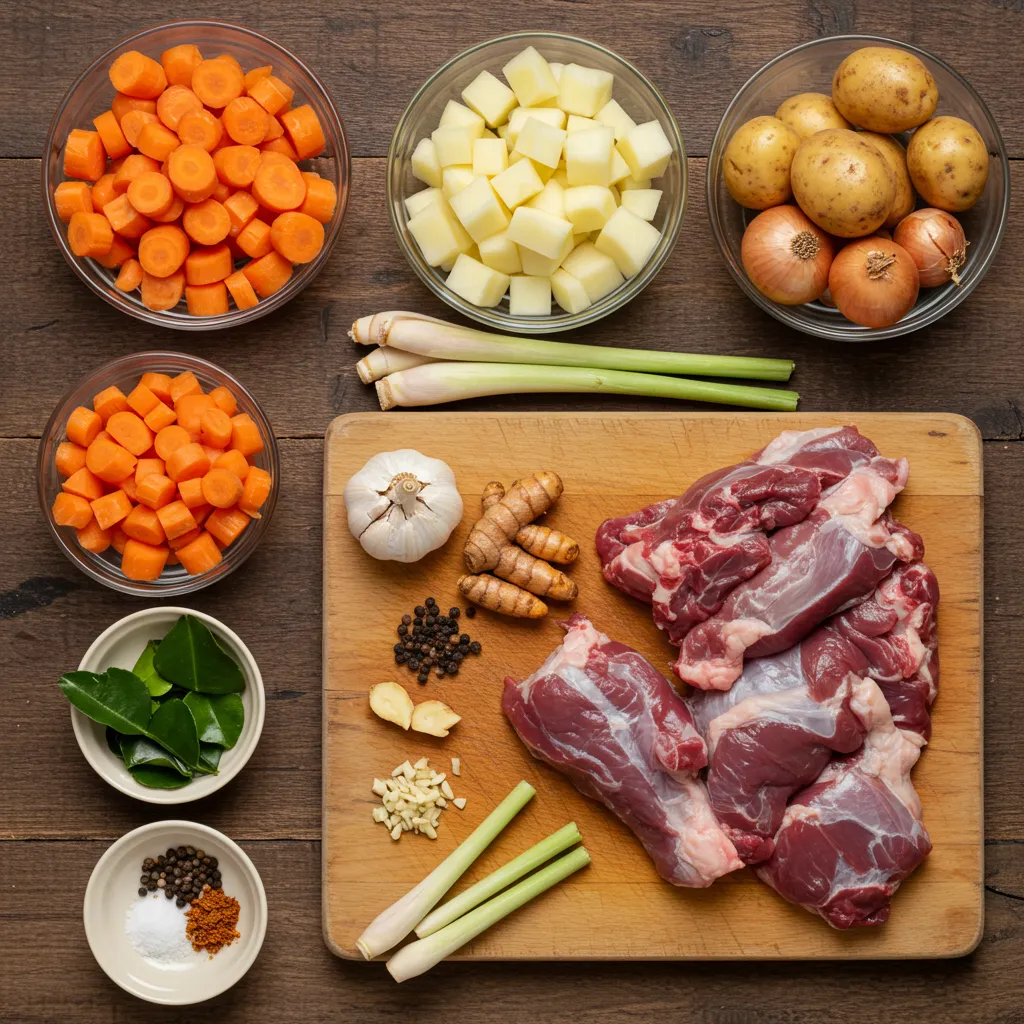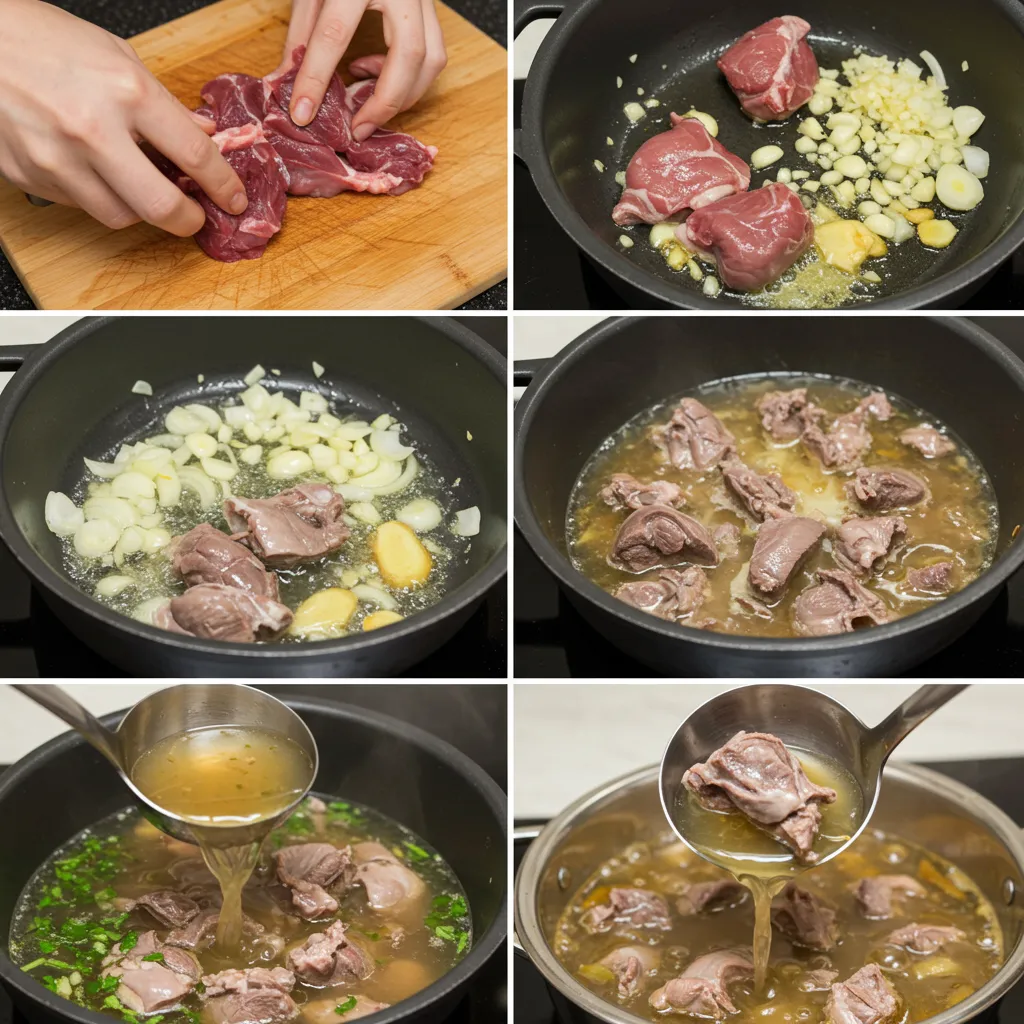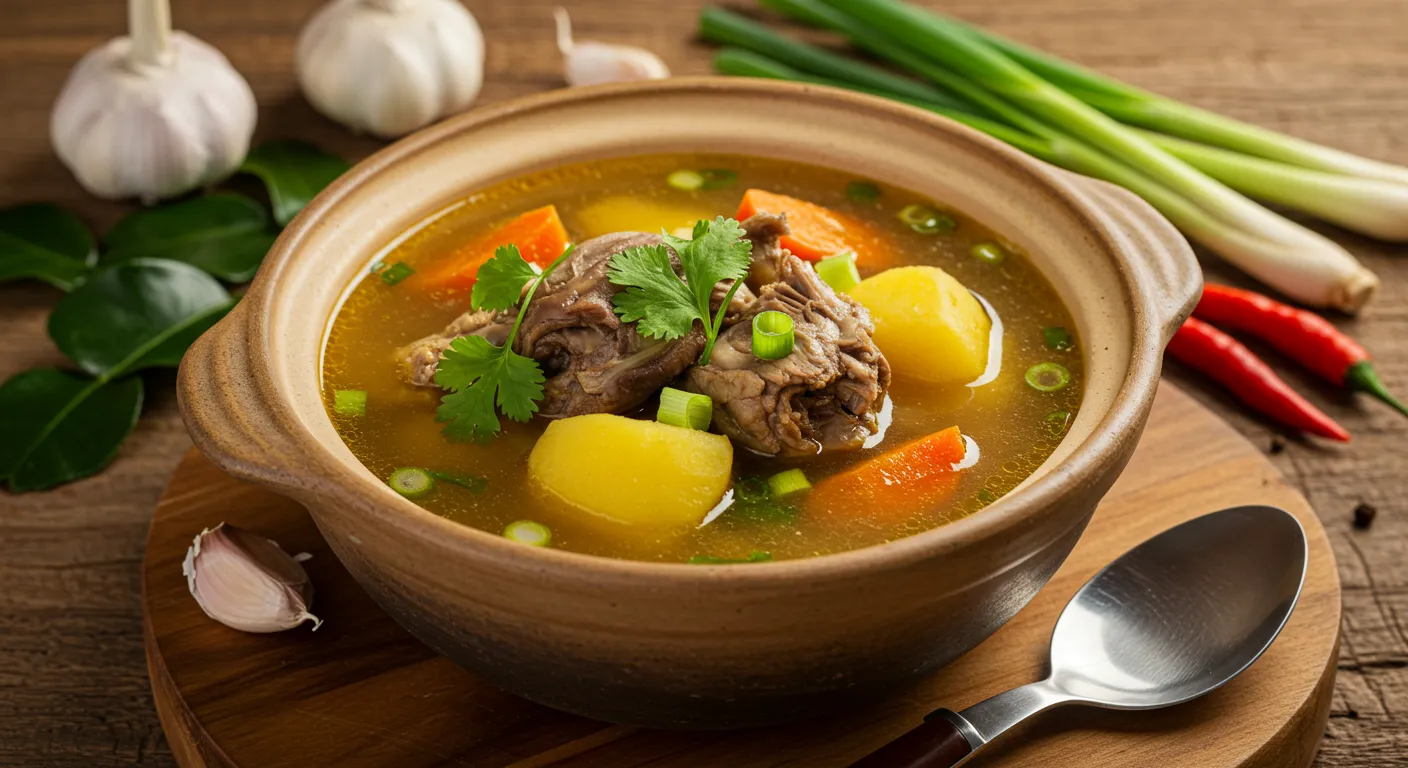Have you ever wondered what makes a truly nourishing and unique soup? Porcupine soup is a traditional dish packed with rich flavors and powerful health benefits. While it might seem unconventional, this nutrient-dense soup has been enjoyed for generations in various cultures.
Slow-simmered to perfection, porcupine soup offers a deep, earthy taste with a tender texture. The natural gelatin from the bones enhances the broth, making it both flavorful and incredibly nutritious. Whether you’re looking for a high-protein meal, an immune-boosting broth, or simply an adventurous dish to try, this soup delivers.
Best of all, it’s adaptable. You can customize the flavors by adding your favorite vegetables, herbs, and spices. It’s perfect for chilly evenings, family gatherings, or anyone eager to explore traditional, wholesome cooking.
Let’s dive into why this soup stands out and how you can easily make it at home.
Print
Porcupine Soup – A Hearty, Nutrient-Rich Dish
- Total Time: 2 hours 20 minutes
- Yield: 4 servings
- Diet: Vegan
Description
Porcupine soup is a rich, flavorful, and nutrient-packed dish made with tender porcupine meat, aromatic spices, and fresh vegetables. Slow-simmered to perfection, this exotic soup delivers high protein, collagen, and immune-boosting benefits. A traditional favorite in many cultures, it’s perfect for a comforting meal, especially on cold days.
Ingredients
Main Ingredients:
- 2 lbs porcupine meat, cleaned and cut into chunks
- 1 large onion, chopped
- 4 cloves garlic, minced
- 1-inch piece ginger, sliced
- 2 medium potatoes, cubed
- 2 carrots, diced
- 2 tomatoes, chopped
- 6 cups water or bone broth
- 1 tablespoon cooking oil
Herbs and Spices:
- 2 bay leaves
- 1 teaspoon turmeric powder
- 1 teaspoon black pepper, crushed
- 1 teaspoon salt, or to taste
- 1 stalk lemongrass, bruised
- 2 tablespoons chopped cilantro or green onions (for garnish)
Optional Add-ins:
- 1 cup coconut milk (for a creamy version)
- 2 chili peppers (for spice)
- ½ cup mushrooms (for extra umami)
Instructions
Step 1: Prepare the Porcupine Meat
- Rinse the porcupine meat thoroughly under cold water.
- Blanch it in boiling water for 5 minutes to remove impurities. Drain and set aside.
Step 2: Sauté the Aromatics
- Heat oil in a large pot over medium heat.
- Add onions and sauté until translucent.
- Stir in garlic and ginger, cooking for 30 seconds until fragrant.
Step 3: Brown the Meat
- Add the porcupine meat and sear on all sides until lightly browned.
- This enhances the depth of flavor in the broth.
Step 4: Build the Broth
- Pour in the water or bone broth.
- Add bay leaves, lemongrass, turmeric, black pepper, and salt.
- Bring to a boil, then reduce to low heat and simmer for 1.5 to 2 hours.
Step 5: Add Vegetables
- Once the meat is tender, add potatoes, carrots, and tomatoes.
- Continue simmering for 20-30 minutes until vegetables are soft.
Step 6: Final Touches
- Taste and adjust seasoning if needed.
- (Optional) Stir in coconut milk and simmer for an extra 5 minutes.
- Remove bay leaves and lemongrass.
- Garnish with fresh cilantro or green onions.
Step 7: Serve and Enjoy
- Ladle the hot soup into bowls and serve immediately.
- Pair with steamed rice or crusty bread for a complete meal.
Notes
- For a milder flavor, soak the meat in vinegar water for 30 minutes before cooking.
- For a thicker broth, allow the soup to simmer uncovered for the last 10 minutes.
- To store leftovers, refrigerate for up to 3 days or freeze for up to 3 months.
- Prep Time: 20 minutes
- Cook Time: 2 hours
- Category: Main Dish
- Method: Simmering
- Cuisine: Traditional / Indigenous
Why You’ll Love This Nutrient-Packed Porcupine Soup
Porcupine soup isn’t just a meal—it’s a powerhouse of nutrition. Made from slow-simmered porcupine meat and bones, this dish is rich in protein, essential minerals, and immune-boosting compounds. Whether you’re looking for a warming comfort food or a unique culinary experience, this soup has something to offer.
Key Benefits of Porcupine Soup
- High in Protein – Porcupine meat is naturally lean and packed with essential amino acids, supporting muscle growth and overall health. Learn more about the benefits of high-protein diets on Harvard T.H. Chan School of Public Health.
- Boosts Immunity – The broth contains minerals like zinc and iron, crucial for a strong immune system. Studies on immune-boosting foods are available at NIH’s National Library of Medicine.
- Supports Digestive Health – Traditional bone broth aids digestion and promotes gut health by providing natural probiotics. Find more information on digestive wellness at Mayo Clinic.
- Sustainable and Natural – As a wild game meat, porcupine is free from antibiotics and hormones, making it a clean, natural protein source. Ethical sourcing insights are available at National Geographic.
A Versatile Dish for Every Occasion
- Perfect for Cold Weather – Its rich, hearty broth is ideal for warming up on chilly nights.
- Great for Adventurous Foodies – If you love trying new flavors, this dish offers a unique taste experience.
- Easily Customizable – Add your favorite root vegetables, herbs, or spices to create a personalized version.
Porcupine soup is more than just a traditional dish—it’s a deeply nourishing meal with a rich history. Ready to make your own? Let’s explore the key ingredients you’ll need.
Ingredients for a Rich and Flavorful Porcupine Soup

The key to making a delicious porcupine soup lies in using fresh, high-quality ingredients. This recipe blends tender porcupine meat, aromatic herbs, and nutrient-rich vegetables to create a deeply flavorful and satisfying dish.
Main Ingredients
- Porcupine meat (2 lbs, cleaned and cut into chunks) – Lean and packed with protein, it provides a rich, earthy flavor.
- Bone-in porcupine pieces (optional) – Adds depth to the broth and releases collagen for a silky texture.
- Onion (1 large, chopped) – Enhances the soup’s savory base.
- Garlic (4 cloves, minced) – Brings a warm, aromatic touch.
- Ginger (1-inch piece, sliced) – Balances the gamey taste and boosts digestion.
- Carrots (2, diced) – Adds natural sweetness and extra nutrients.
- Potatoes (2 medium, cubed) – Makes the soup heartier and more filling.
- Tomatoes (2, chopped) – Gives the broth a slightly tangy depth.
Herbs and Spices
- Bay leaves (2) – Infuses the broth with a subtle herbal aroma.
- Turmeric (1 teaspoon) – Adds warmth and anti-inflammatory benefits.
- Black pepper (1 teaspoon, crushed) – Enhances the overall flavor profile.
- Salt (to taste) – Brings out the natural flavors of the ingredients.
- Lemongrass (1 stalk, bruised) – Adds a hint of citrusy freshness.
- Cilantro or green onions (for garnish) – Provides a vibrant finishing touch.
Liquid Base
- Water or bone broth (6 cups) – The foundation of a rich, nourishing soup.
- Coconut milk (1 cup, optional) – For a creamy, slightly sweet variation.
Optional Add-Ins
- For a spicy twist, add chili peppers to elevate the heat level.
- Mushrooms – Enhance the depth of flavor with a rich umami boost.
- Leafy greens (spinach or kale) – Boosts the soup’s nutritional value.
This ingredient list ensures a balanced, flavorful, and nutrient-dense porcupine soup. Next, let’s walk through the step-by-step cooking process.
Step-by-Step Instructions for Making Porcupine Soup
Cooking porcupine soup is a slow, rewarding process that allows the flavors to develop beautifully. Follow these steps to create a rich, hearty broth infused with aromatic herbs and spices.
1. Prepare the Porcupine Meat
- Clean the porcupine meat thoroughly under running water.
- If using bone-in pieces, blanch them in boiling water for 5 minutes to remove impurities.
- Rinse and set aside.
2. Sauté the Aromatics
- Warm a large pot over medium heat and drizzle in a tablespoon of oil.
- Cook the chopped onions until they turn soft and translucent.
- Stir in the garlic and ginger, sautéing for about 30 seconds until aromatic.
3. Brown the Meat for Extra Flavor
- Add the porcupine meat to the pot and sear on all sides.
- Let it cook for a few minutes until it develops a slight golden crust.
- This process deepens the richness and complexity of the broth’s flavor.
4. Build the Broth
- Pour in the water or bone broth and bring it to a gentle boil.
- Add the bay leaves, lemongrass, turmeric, black pepper, and salt.
- Reduce the heat and let it gently simmer uncovered for 1.5 to 2 hours.
- Occasionally skim off any foam or impurities that appear on the surface.
5. Add the Vegetables
- Once the meat is tender, add the carrots, potatoes, and tomatoes.
- If using mushrooms or chili peppers, add them at this stage.
- Let it simmer for an additional 20–30 minutes until the vegetables become tender.
6. Final Adjustments and Garnishing
- Sample the broth and adjust the seasoning to your preference.
- For a creamier texture, stir in the coconut milk and let it simmer for 5 more minutes.
- Remove the lemongrass and bay leaves before serving.
- Top with fresh cilantro or green onions for a vibrant, refreshing touch.
7. Serve and Enjoy
- Spoon the steaming soup into bowls and serve right away.
- Pair it with steamed rice or crusty bread for a complete meal.
- Keep any leftovers in an airtight container and refrigerate for up to three days.
This step-by-step method ensures a deeply flavorful, nourishing porcupine soup with a perfect balance of rich broth, tender meat, and hearty vegetables. Next, explore expert tips and variations to customize this dish even further.

Pro Tips and Variations for the Best Porcupine Soup
Cooking porcupine soup is a rewarding experience, but a few expert techniques can elevate the flavors even further. Whether you want to enhance the richness, adjust it for dietary needs, or experiment with new ingredients, these tips will help you customize the dish to your liking.
Expert Tips for Maximum Flavor
- Slow Simmer for Deep Flavor – Let the soup cook over low heat for at least two hours. This allows the broth to extract nutrients from the bones and develop a rich, hearty taste.
- Skim the Broth for Clarity – Remove any impurities that float to the surface to keep the broth clear and clean-tasting.
- Marinate the Meat – Before cooking, soak porcupine meat in a mixture of vinegar, salt, and water for 30 minutes to reduce any gamey flavor.
- Use Fresh Herbs – Fresh lemongrass, cilantro, and green onions bring brightness to the dish and balance the richness of the broth.
- Enhance with Coconut Milk – For a creamier, slightly sweet twist, add coconut milk in the final 10 minutes of cooking.
Customizable Variations
- Spicy Version – Add sliced chili peppers or a dash of cayenne for a bold kick.
- Vegetable-Packed Option – Toss in leafy greens like spinach or bok choy for extra nutrients.
- Low-Carb Adaptation – Skip the potatoes and replace them with cauliflower or zucchini.
- Keto-Friendly Twist – Use bone broth instead of water and add more fatty cuts of meat for a higher fat content.
- Vegan Alternative – If you love the broth but want a plant-based version, swap the porcupine for mushrooms and tofu while keeping the same aromatic spices.
Storage and Meal Prep Tips
- Make Ahead – The flavors deepen overnight, so consider making it a day in advance for even better taste.
- Proper Storage – Store leftovers in an airtight container in the refrigerator for up to three days.
- Freezing Option – Portion the soup into freezer-safe containers and freeze for up to three months. Reheat slowly on the stove to preserve the flavors before serving.
With these expert tips and variations, you can create a porcupine soup that suits your taste preferences and dietary needs. Now, let’s explore the best ways to serve and enjoy this flavorful dish.
Serving Suggestions for the Best Porcupine Soup Experience
Porcupine soup is a hearty, nourishing dish that pairs well with a variety of sides and accompaniments. Whether you’re serving it as a comforting meal on a cold night or as part of a larger feast, the right presentation and pairings can elevate the experience.
Best Ways to Serve Porcupine Soup
- With Steamed Rice – A bowl of fluffy white or brown rice absorbs the rich broth, making the meal more satisfying.
- Alongside Crusty Bread – Thick slices of toasted bread are perfect for dipping into the flavorful soup.
- With a Side of Fresh Vegetables – Serve with a crisp cucumber salad or steamed greens to balance the richness.
- As a Standalone Dish – Enjoy it on its own for a light yet nourishing meal.
Presentation Tips for a Visually Appealing Dish
- Use a Deep Bowl – This allows the broth to stay warm longer and keeps all the ingredients well-mixed.
- Garnish for Freshness – Sprinkle chopped cilantro, green onions, or a squeeze of lime for a vibrant finish.
- Add a Spicy Kick – Serve with chili flakes or hot sauce on the side for those who love extra heat.
Storage and Leftover Tips
- Refrigeration – Store leftovers in an airtight container and refrigerate for up to three days. Warm slowly on the stove to maintain the texture and enhance the flavor.
- Freezing for Later – Freeze portions in sealed containers for up to three months. Let it defrost in the refrigerator overnight before warming up.
- Reheating for Best Taste – Simmer on low heat and add a splash of water or broth if the soup has thickened.
Serving porcupine soup with the right pairings and thoughtful presentation makes it even more enjoyable. Now, let’s wrap up with a final note on why this dish is worth trying.
Conclusion: Why Porcupine Soup Is a Must-Try
Porcupine soup is more than just a unique dish—it’s a flavorful, nutrient-rich meal packed with health benefits. Whether you’re drawn to its high protein content, immune-boosting properties, or simply its rich, comforting broth, this traditional recipe offers something special.
It’s a versatile dish that can be adapted to different flavor profiles and dietary needs. You can make it spicy, creamy, or packed with vegetables to suit your preference. Plus, with proper storage, it’s a great make-ahead meal that tastes even better the next day.
If you enjoyed this recipe, you might also love these flavorful and nutrient-dense dishes:
- Better Than Sex Fruit Salad – A refreshing and vibrant dish that pairs well with hearty soups.
- Beef Kidney Recipe – Another high-protein dish packed with nutrients.
- Taco Soup Frios Recipe – A comforting, hearty soup for any season.
- Vegetable Stir-Fry for Dinner – A quick and nutritious side dish that complements this soup.
- The Ultimate Guide: What Is the Best Thing to Marinate Meat In? – Perfect if you want to enhance the flavor of wild game meat before cooking.
- How to Make Mustard at Home – A great condiment to pair with game meats and soups.
- What Is Flavored Vinegar? – Learn how to infuse vinegars to enhance your soups and stews.
- The Ultimate Guide to Truffle Hot Sauce – A luxurious addition for those who love bold flavors.
Have you tried making porcupine soup before? Share your thoughts, variations, or favorite ways to enjoy this dish in the comments below!
FAQs About Porcupine Soup
Porcupine soup is a unique and hearty dish, and you may have a few questions before making it. Here are the most common queries, along with helpful answers to ensure the best cooking experience.
1. Can I Make Porcupine Soup Ahead of Time?
Yes. In fact, porcupine soup develops even deeper flavors when made a day in advance. Keep it sealed in an airtight container and refrigerate for up to three days. When reheating, simmer gently to preserve the broth’s richness.
2. How Do I Reduce the Gamey Flavor?
Soaking the porcupine meat in vinegar and water for about 30 minutes before cooking helps mellow out any strong taste. You can also marinate it with spices like turmeric, black pepper, and lemongrass for added depth.
3. Can I Freeze Porcupine Soup?
Yes. Once cooled, store the soup in freezer-safe containers for up to three months. Thaw it overnight in the refrigerator and reheat over low heat to maintain the best texture and flavor.
4. What Are the Best Vegetables to Add?
Some great vegetable additions include:
- Carrots and potatoes – For heartiness and natural sweetness.
- Tomatoes – To enhance the broth’s depth.
- Leafy greens (spinach, kale, or bok choy) – For extra nutrients.
- Mushrooms – To add umami and a meaty texture.


Nice and Yummy !
Nice recipes